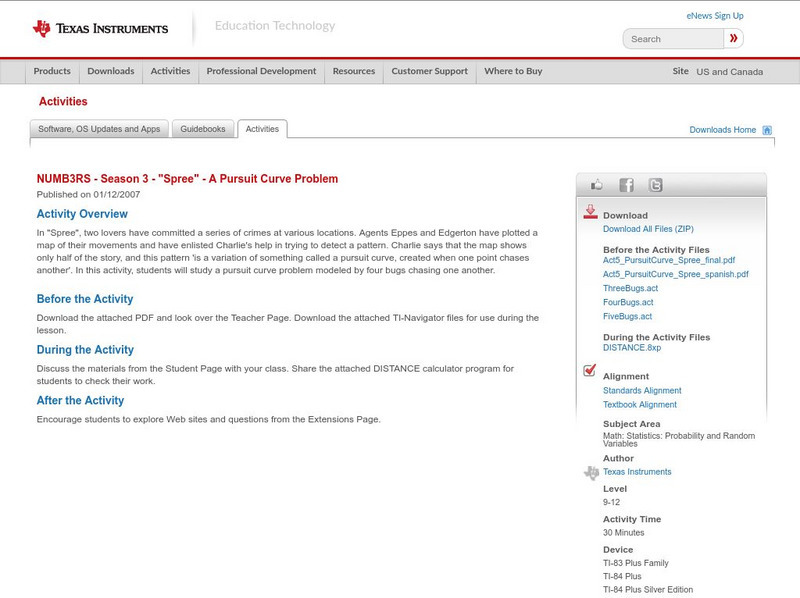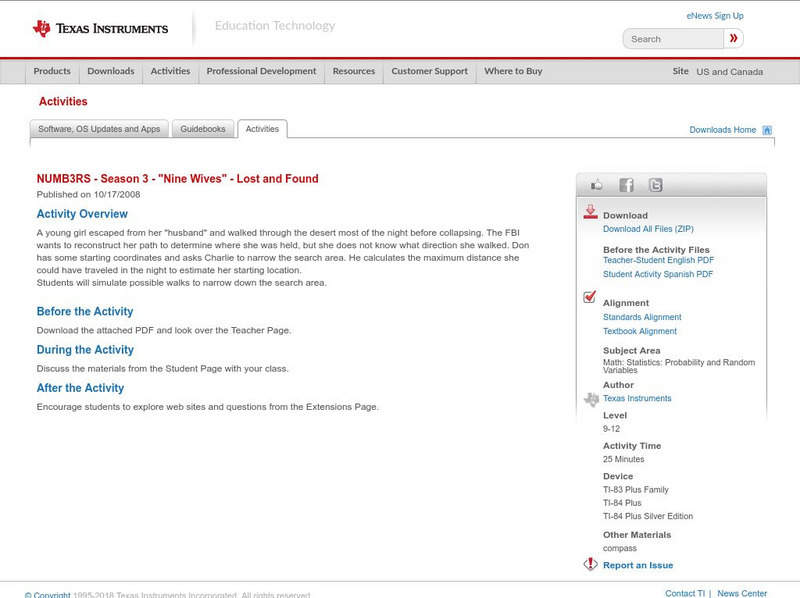Hi, what do you want to do?
Texas Instruments
Texas Instruments: Law of Large Numbers: Equal Opportunities
In this activity, students can use the Probability Simulation application to roll a fair die and explore the Law of Large Numbers. They will conduct probability experiments that involve tossing a fair die, graph the results, compare the...
Shodor Education Foundation
Shodor Interactivate: Two Colors
Students investigate conditional probability. This activity allows the user to simulate pulling red and green balls out of boxes. Teacher resources are included.
Texas Instruments
Texas Instruments: Numb3 Rs: A Mathematics Sampler
Based off of the hit television show NUMB3RS, this lesson introduces students to the notion of conditional probability, by having them consider a jar of various colored gumballs. The lesson makes brief use of the Probability Simulator on...
Texas Instruments
Texas Instruments: Heads Up! (Continued)
In this activity, students explore how to write and enter a calculator program that will simulate coin tossing for a given number of times and count the number of heads and tails. They analyze the program and modify it.
Texas Instruments
Texas Instruments: The Birthday Problem
In this activity, students use simulations to answer a popular question involving probabilities.
Shodor Education Foundation
Shodor Interactivate: Advanced Fire
Run a simulation of how a fire spreads through a stand of trees, learning about probability and chaos. Track the results of multiple burns and use the data to draw conclusions.
Shodor Education Foundation
Shodor Interactivate: Fire!!
Run a simulation of how a fire will spread through a stand of trees, learning about probability and chaos.
Shodor Education Foundation
Shodor Interactivate: Buffon's Needle
Experiment with a simulation to get an approximation of Pi by dropping a needle on a lined sheet of paper.
Texas Instruments
Texas Instruments: Numb3 Rs: A Pursuit Curve Problem
Based off of the hit television show NUMB3RS, this lesson introduces students to pursuit curves, in which objects follow seemingly awkward paths due to other objects chasing it. In this lesson (which is technology intensive), students...
Texas Instruments
Texas Instruments: Numb3 Rs: Lost and Found
Based off the hit television show NUMB3RS, this lesson introduces students to chaos theory, and specifically Levy flight paths. These allow students to "trace back" where an object may have originated, given its endpoint. This lesson is...
Texas Instruments
Texas Instruments: Spread Out #1
This exploration uses baseball's slugging average to explore variance and standard deviation.
Education Place
Houghton Mifflin: Eduplace: Extra Practice Quiz Which Spinner Is Fair?
Decide which spinner is fair for each of the probability examples presented. Read the interactive quiz rules and then click on the "Begin" ticket. If you answer incorrectly you get one more chance to try again then you are told the...
PBS
Pbs Teachers: Whirlybirds [Pdf]
Predict and determine the frequency of an event and measure to the nearest centimeter while constructing whirlybirds in a simulation of a parachute jump competition.
Texas Education Agency
Texas Gateway: Tea Statistics: Discrete Distribution (Playing Card Experiment)
In this Stats lab, students will work with a set of playing cards and a calculator. They will compare empirical data and a theoretical distribution to determine if an everyday experiment fits a discrete distribution. They will compare a...
Biology Corner
Biology Corner: Pipe Cleaner Babies
Using chromosome and gene models, students play the roles of two parents in this genetics simulation. The object is to create four offspring and determine their genotypes and phenotypes, and determine the probability of having offspring...
Texas Instruments
Texas Instruments: Gambler's Fallacy: Lucky Streaks and Slumps
In this activity, students determine the probability of independent and compound events. They design simulations and collect data to explore streaking behavior.
Other
Walter Fendt: Ley De La Desintegracion Radiactiva
Learn how you can find the probability of survival but cannot predict the time of disintegration of an atomic nucleus with this simulation. This site is best viewed with Internet Explorer.

















